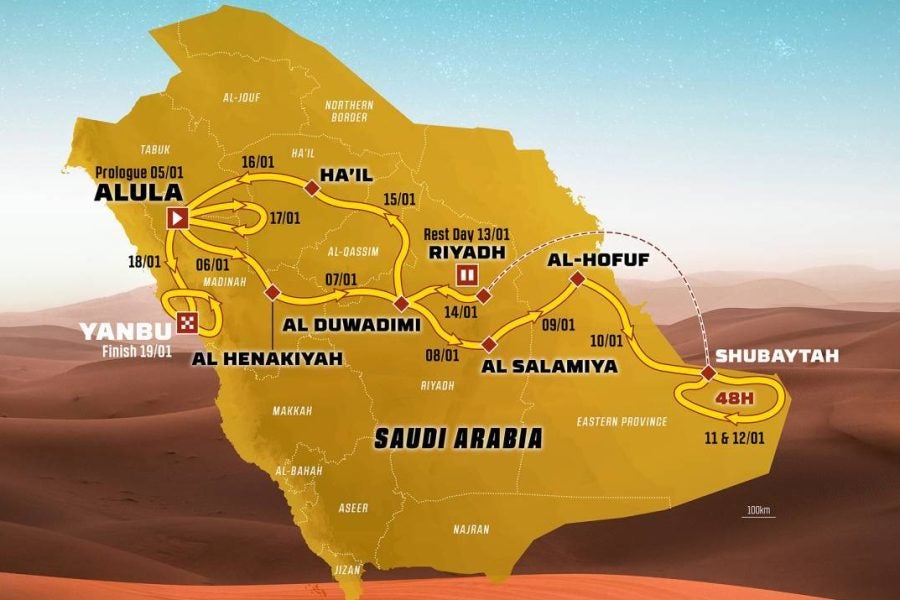As the 2024 Dakar Rally looms around the corner, the ASO (the body that organizes the race) has just dropped an announcement of what to expect this year. We’ll go into a bit more detail below, but the TL/DR is this:
- The race is still in Saudi Arabia, and Saudi Arabia alone.
- The marathon stage formula is changing again
- The Dakar Classic returns
- They’re still trying to figure out how to “greenwash” the race
- Did we mention that race is once again solely running in Saudi Arabia?
If you want a few more details, read on:
The Saudi route
The Dakar Rally’s contract restricts it to running solely inside the borders of this Middle Eastern country, which most of us will recognize as being nowhere near Dakar. Not only is the race far removed geographically from its original Paris-to-Dakar route, it’s also far removed from its roots as a trans-continental race. Once again in 2024, the riders are simply doing an in-country loop—even in its South American days, the race was at least a wild traverse of many kinds of terrains, across multiple countries.
But enough whining! Here’s what to expect from this year’s route. David Castera, race director, said “We took it upon ourselves to make the fifth edition of Saudi Arabia the toughest one since the race came to the Middle East.” Yes, we’ve heard that before… and yet we always see stages canceled due to danger, or even some breaks handed out to top racers…
The race will kick off on January 5 in AlUla, and run for 7,891 km. That includes 4,727 km of specials, and once again, riders will visit the deserts of the Empty Quarter, where organizers have added more drama. The race ends on January 19 this year.
The new marathon stage
The usual “no-mechanics-allowed” marathon stage comes early this year, starting with Stage 3. However, organizers have added a second marathon stage, sort of, running in the Empty Quarter. On this stage, the organizers will put together six different campsites in the desert. At the 4 PM mark of the afternoon, the rally raiders must stop their racing and head to the next campsite down the road. In other words, it’s a marathon stage but split among several bivouacs.
Why do things this way? It’s possible Dakar organizers are just messing with the formula to try to build interest back in the event, and it’s also possible there’s something else at play. Maybe this is a way of deterring some of the hanky-panky and underhanded hijinks that have often been alleged at the marathon stages? It would certainly make it harder to fix your bike, if there was no guarantee of a teammate to donate needed parts.
Dakar Classic returns… but no motos?
We’ve been waiting for a return to classic motorcycles in this category, but from what we can tell, it’s all cars again in 2024. Bummer. We want to see big old twin-cylinder Beemers thrashed in the sand dunes again…
Greenwashing the race
Like every other major race series, Dakar organizers are worried about carrying on with their petrol-happy ways as global leaders crack down on internal combustion engines. With that in mind, Dakar’s press announcement says this:
MISSION 1000: TURBOCHARGING THE FUTURE
The Mission 1000 challenge was rolled out as part of the Dakar Future programme, which set 2030 as the target date for the wholesale use of alternative energies in the Dakar. It provides a testbed where cutting-edge technologies can be put to the test on the terrains of the Dakar without having to go through excessively long and hard stages. A new concept has been developed: a 100 km section separate from the stages that make up the rally, adding up to 1,000 km on which the constructors can find out what technical options are worth pursuing in the future. The nine vehicles embarking on this adventure will make their first appearance at the start of the prologue in AlUla. While the challenge is not intended as a competition, several assessment criteria have been defined to put the vehicles through their paces and keep the riders and drivers on their toes. Three engine types have been selected for Mission 1000: fully electric / fully hydrogen-powered / hybrid technology.
So they plan on wholesale alternative energy in only six years, when at this point, no such viable alternative has been found, considering the capabilities necessary for this event? Good luck, gentlemen. The Dakar may indeed run on hydrogen or battery power or some sort of hybrid tech in 2030, but unless the limitations and expense of these vehicles changes drastically in the next half-decade, you can probably say the race will be unrecognizeable at that point. But then, many long-time fans would say that already. This is in no way a detraction from the challenge and difficulty of the event itself, not one bit—but things have changed drastically since the Dakar stopped actually running to Dakar… battery bikes and hydrogen cars will really just be continuing the trend of the past 15 years.







